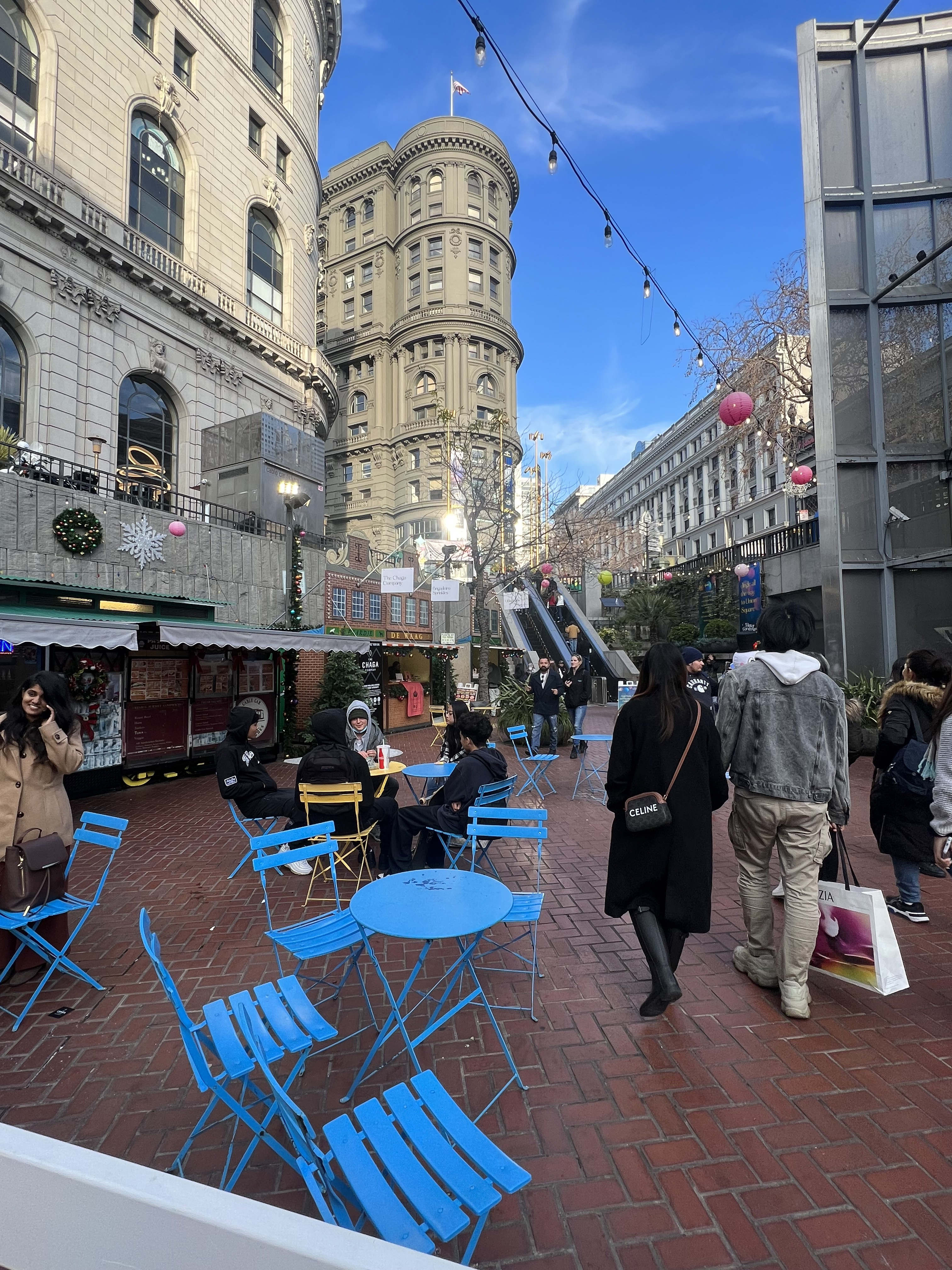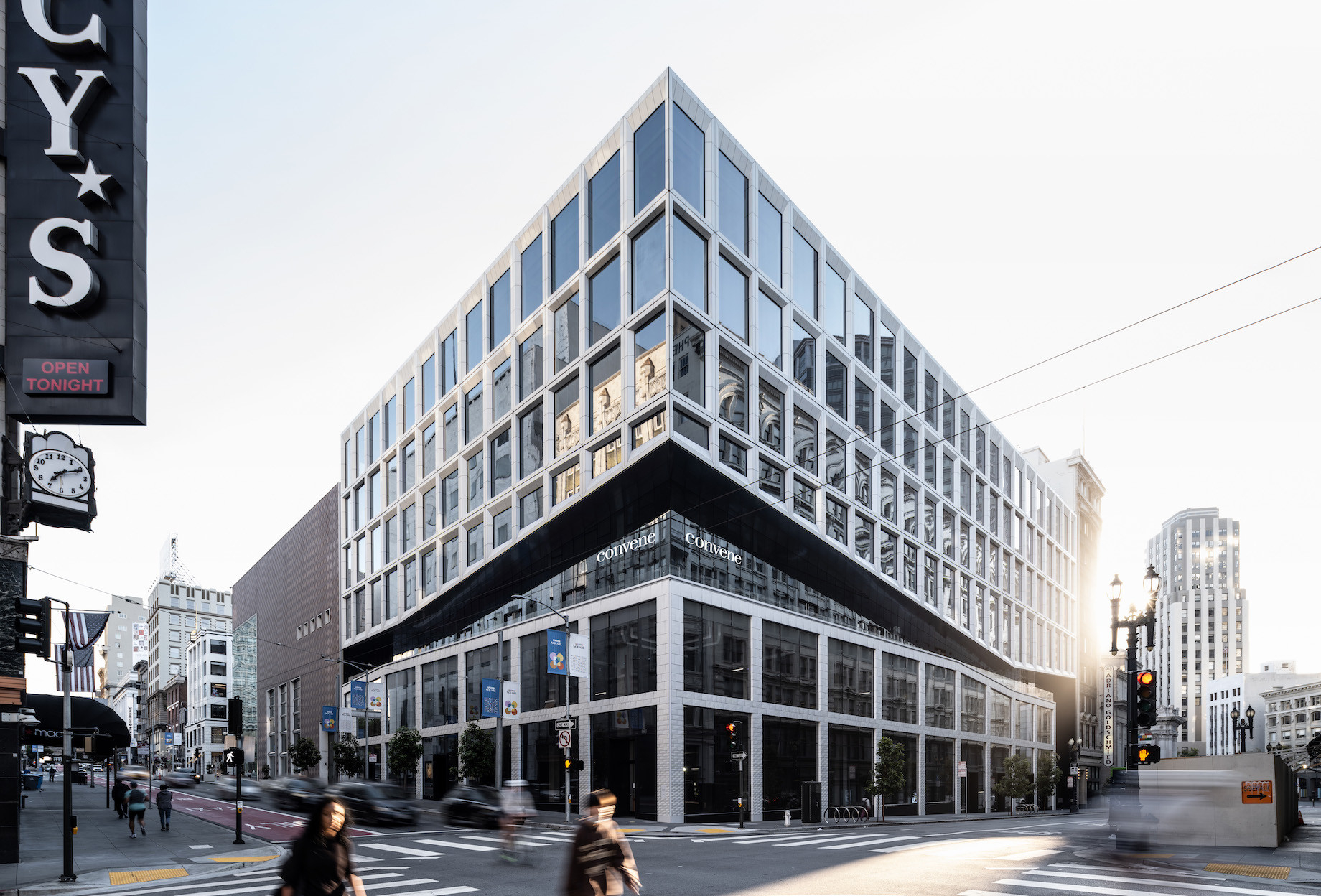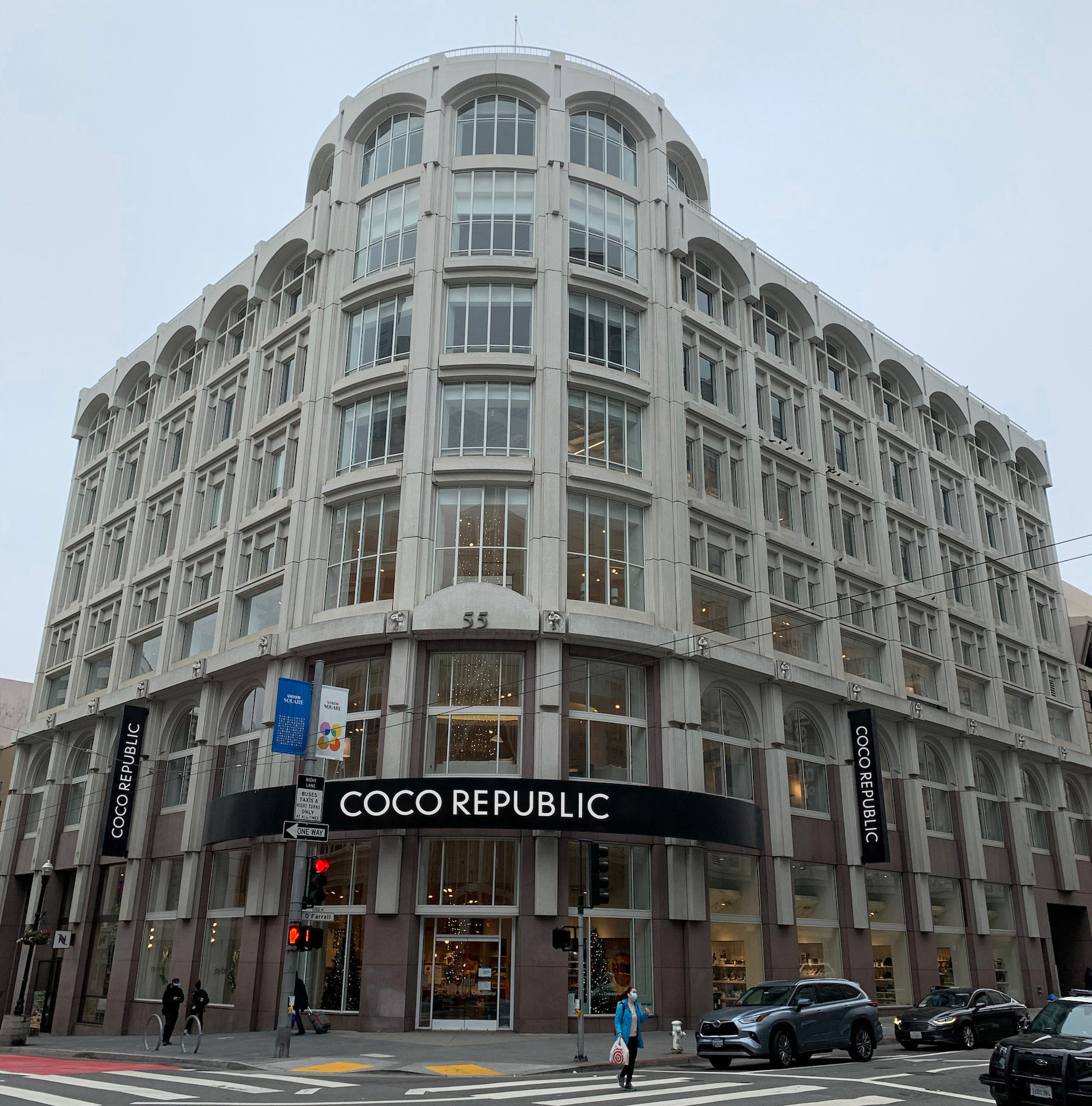Cushman & Wakefield executive vice chair Kazuko Morgan lost a major deal last year in downtown San Francisco’s Union Square. To be sure, the commercial district’s struggles with trash, burglary, loitering and record-high vacancies had been making unwelcome headlines. But as the veteran broker sees it, the real culprit was out-of-date zoning. “We had a global retailer that wanted to fill an entire building with retail and their headquarters, but the zoning just would not allow it,” Morgan said. “It was a real shame. We have lost so many fantastic opportunities with tenants in Union Square because the zoning is so restrictive.”
San Francisco Mayor London Breed and other city officials have joined Union Square boosters in calling for an overhaul of that zoning framework. They were inspired to do so in part by a revitalization plan created with the help of researchers and city planners from the consultancies Streetsense and MIG.
A Prior Bet on Flagships
Union Square is a 27-block district surrounding Union Square Plaza and bounded by Bush, Kearny, Market and Taylor/Mason streets. The district’s current zoning regime, which prioritizes multilevel retail, dates to the 1980s, an era when retailers battled for scarce flagship and department store space in Union Square and city planners wanted to keep the fast-growing office sector relegated to the Financial District. “There were two goals for the zoning that was put in place at that time and that we still have,” explained Union Square Alliance COO Ken Rich, a former San Francisco development director and city planner. “The first was to assume it would all be flagship, multistory retail. The second was to keep office towers from encroaching across Kearny Street, which is the boundary between the Financial District and Union Square.”
With time, tenants’ changing leasing priorities began to conflict with Union Square’s ’80s-era zoning rules. Brokers began losing deals with fast-growing tech companies and other nonretail users that were prevented from taking certain above-ground-floor spaces. On the retail side, the zoning codes stymied a new crop of digitally savvy operators that wanted to lease smaller storefronts. “It is a huge hurdle to entry if you have to take two stories instead of just the first floor,” said Streetsense managing director Larisa Ortiz. “Digital native brands and other smaller, bespoke businesses might want to be in Union Square, but they don’t need a lot of space. Effectively, they were prevented from entering the market.”
Even before the pandemic, department store chains and global brands were closing large-format stores in downtown districts. The COVID-19 lockdowns only accelerated the trend. Since 2019, Union Square has lost Barneys, Forever 21, Uniqlo, Marshalls, H&M, DSW and Abercrombie & Fitch, among other retailers. “Union Square has gone from being one of the tightest markets in the country, with vacancy of less than 3%, to having over 30% availability,” Morgan said. “Availability doesn’t necessarily mean fully vacant. It means these are spaces where we know tenants would exit early if given the opportunity.”
According to Cushman & Wakefield, Union Square closed out the fourth quarter of 2022 with an office vacancy rate of 26.4% and a retail vacancy rate of 12.3%. By comparison, in the pre-pandemic fourth quarter of 2019, those numbers were 7.3% for office and 6.4% for retail.
The Union Square Alliance last year tapped Streetsense and MIG to develop an action plan for the district. When the report was released this past November, Mayor Breed and other city officials were on hand to endorse the proposal. Alliance COO Rich said the research highlighted the need for a new approach.
Particularly impactful, Rich said, was a Streetsense analysis showing that Union Square’s zoning framework called for retail leasing volume akin to that of the massive Mall of America. “When Streetsense looked at those Union Square buildings where the zoning either required or strongly encouraged retail, they came up with a total of 5 million square feet,” he explained. “While there is strong retail demand in central San Francisco and Union Square, it is not even close to 5 million square feet. … Our buildings will remain empty if owners are forced to look for retail tenants that are not out there.”
Historical Needs Versus Today’s
A former New York City planning commissioner, Ortiz has seen zoning rules create leasing challenges for downtown districts around the country. While mall landlords can exercise centralized control to strike the right tenant mix, she noted, downtown districts often use zoning to try to impose their priorities on otherwise independent building owners and tenants. “Zoning is a really blunt and not particularly sophisticated tool to control or determine tenant mix,” she said, likening older zoning codes to “a historical record of what people had issues with at a certain period of time.”
Back in the 1950s, for example, officials in the sailing town of Norfolk, Virginia, acted to restrict the tattoo parlors they then saw as onerous, Ortiz said. Today, Americans tend to be much more open to these businesses. “Now every Millennial has a tattoo,” she quipped. Likewise, in the 1970s, New York City tried to zone prostitution and massage parlors out of then-seedy Times Square. But today, those regulations governing so-called “physical culture or health establishments” can make it harder for legitimate operators to lease space. “Every gym that wants to fill space in New York City still has to jump through hoops,” Ortiz said.
While some officials still resist calls for zoning reform, communities with high vacancy rates tend to be more receptive to change, she said. “When every third storefront is vacant, everyone acknowledges that the problem needs to be addressed.”
Count Union Square in that latter camp. According to Union Square Alliance CEO Marisa Rodriguez, the groundswell in San Francisco is such that a new zoning framework could pass by the end of 2023. “We’re excited and appreciative because we feel that we really have the support of the city, which is important.”
Focusing on Flexibility
Today, nonretail businesses of more than 5,000 square feet are required to obtain a conditional use permit to lease ground-floor space in Union Square. The same is true of office and nonretail tenants seeking space on any of floors 2 through 6. In addition, Ortiz noted, under the current rules, converting existing space into residential may require expensive and time-consuming special permissions. “The minute you start going through the special permitting process, you enter a discretionary approval process, which is notoriously challenging, expensive and long,” the consultant said. “In an expensive development environment like San Francisco, these are the kinds of things that will give a developer pause.”
As announced by the alliance, the action plan calls for zoning changes that will “ensure all floors of Union Square buildings are occupied with vibrant activities” and that “facilitate a resilient, mixed-use, downtown neighborhood.” Rodriguez said the focus is on flexibility. “If Chanel wants three, four or 10 levels, we’re all for that,” she said. “We’re not trying to get rid of the three-level flagship stores from years past. However, we also want to be mindful of how things are shifting.”
The plan also calls for a Tenant Recruitment Consortium made up of building owners, brokers, city officials and the Union Square Alliance. “It’s all about bringing parties together and having a dialogue,” Rodriguez said. “What should we be seeing in Union Square?” In addition to bringing a big-picture view, alliance members could connect retailers and food-and-beverage operators with city officials for talks on potential financial incentives. “Figuring out how to attract F&B tenants, which may not be able to pay as much rent as luxury retailers, is not something you can solve at the level of individual brokers or deals,” Rich explained. “You need to engage with the city and ask: ‘How can we work with you to make this more affordable for restaurants?’ We are just starting on that journey.”
Pushing Back Against Negative Press
With few permanent residents, Union Square lost its typical daytime population when San Francisco’s COVID-19 shelter-in-place regulations were in effect, replaced by trash, crime and loitering. Then came the November 2021 looting of upscale retail stores there, including the “emptying out” of Louis Vuitton’s Geary Street flagship. So the Union Square action plan, in addition to its focus on zoning, calls for cleaning up the district and making it safer, particularly at entry points like the transit station and parking garages.
According to the city and the alliance, Union Square already has made progress toward those goals. The San Francisco Police Department stepped up its patrols. The city also hired retired officers to maintain a presence in the district as “ambassadors.” According to a municipal press release, assaults, burglaries and larcenies/thefts have decreased dramatically. “What the city has done to secure and make our district safe has been remarkable,” Rodriguez said. “We got the services and police support we needed. … Union Square does not feel overpoliced; it just feels right.”
Meanwhile, the action plan calls for upgrading Union Square’s outdoor public spaces, including Hallidie Plaza, Powell Street and key alleyways. Working with the city’s parks department, Rodriguez is using city grants and retailer sponsorships to ramp up music, events and art programming. She also wants to bring in more food vendors and pop-up retail. This coming March, she noted, the BloomSF festival will bring music and art installations to the district. “Just imagine an explosion of florals — maybe a stop sign, a fountain, an alleyway or a hotel awning, all blooming.”

Hallidie Plaza and other public spaces would get an upgrade under a proposed revitalization plan for San Francisco’s Union Square.
Nonetheless, high-profile coverage of the burglaries and the negative stories about the cratered office market in downtown San Francisco mean that Union Square also needs to get out the word about its positive momentum, Morgan said. The broker pointed to The New York Times’ December 2022 piece What Comes Next for the Most Empty Downtown in America as particularly irksome. “Do we have street conditions and issues? Like any major American city right now — and certainly on the West Coast — we do, but it is not the doom-and-gloom that keeps getting portrayed.”
RELATED: Where Foot Traffic Stands in Urban Shopping Corridors
In fact, she said, Union Square is recovering nicely, as major leases were signed last year and new ones are in the works. Cushman & Wakefield, for one, brokered a deal with Convene for 65,400 square feet on the fourth and fifth floors at 100 Stockton St.

Meeting space provider Convene — which designs, builds and manages meeting, event and flexible office spaces — recently leased the fourth and fifth floors of 100 Stockton St., where the Macy’s Men’s department store once stood. Image courtesy of Convene. Photo by Gensler, Jason O’Rear
In another Cushman & Wakefield deal, Australian furniture retailer Coco Republic leased space at 55 Stockton St. Last year, the brokerage firm also did a deal with Banana Republic for 8,740 square feet on Geary, It’Sugar for 21,500 square feet on Stockton and The Friends Experience pop-up for 43,800 square feet on Powell.

Coco Republic opened a 53,000-square-foot store at 55 Stockton St. in the fall.
Cushman & Wakefield’s fourth-quarter 2022 report cited other notable Union Square retail deals, including Ross Dress for Less for 40,300 square feet on Market Street, Kerns Fine Jewelry’s new Rolex & Patek Philippe boutique for 6,800 square feet on Post Street and Samsung’s Galaxy Experience pop-up for 29,100 square feet on Powell.
Morgan credited landlords for being flexible enough to make deals happen in the new retail environment: “Historically, we have been a zero [tenant-improvement allowance] market, but some landlords are giving TI and doing what they need to do to get good brands into their spaces.”
In general, Rodriguez added, retail performance and foot traffic are on the upswing in Union Square. She cited the district’s 15% increase in foot traffic in 2022. Added Morgan: “We’ve had retailers that had stronger sales last year than what they saw in 2019.”
Several retailers, including Italian luxury brands Brunello Cucinelli and Bottega Veneta, have expanded their stores in the district, and the Geary Street expansion of high-end French designer Saint Laurent is now under construction. “Chanel will be doubling in size,” Morgan said. “They bought a 17,180-square-foot building a little over a year ago.” She described the expansions as noteworthy given Union Square’s reductions in office and retail occupancy, tourism and conventions over the past few years. And according to Rodriguez, conventions are starting to return, as well, the latest being last month’s 41st annual J.P. Morgan Healthcare Conference.
A New Model
If the zoning reform passes as expected, Rich said, Union Square retailers will be freer to locate on the first floor and on higher floors as needed. Meanwhile, residential, office and other nonretail users will face fewer obstacles. The demand, he said, is there. For example, a developer is already converting part of the former Barneys at 48 Stockton into high-end, boutique office space.
The former city official added that Union Square could benefit further by encouraging more residential conversions via tax incentives and breaks on impact and permitting fees. Residential, he explained, likely bolstered the resilience of other cities during the pandemic. “It’s about more than just relaxing the zoning, but any zoning change showing more flexibility will definitely be a win for Union Square.”
By Joel Groover
Contributor, Commerce + Communities Today